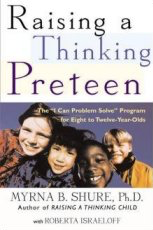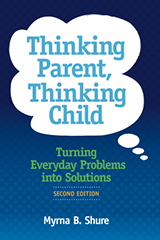Raising a Thinking Preteen
The "I Can Problem Solve" Program for Eight- to Twelve-Year-Olds
 by Myrna B. Shure, Ph.D. with Roberta Israeloff
by Myrna B. Shure, Ph.D. with Roberta Israeloff
Excerpt
Back to main Raising a Thinking Preteen page
Four Styles of Parenting
If we change the way we talk to kids, it will change the way they talk to us, to other kids, and to themselves.
What do parents say when they want to change their child's behavior? After listening to and studying parents' approaches for years, I've concluded that much of the time they resort to one of three strategies: they use power, suggestions, or explanations.
Obviously, not everything we say or do when we are trying to change our children's behavior falls into one of these categories. There are also times when we use two or three of these approaches at once. Still, examining our behavior through this broad lens is useful. It will help us to see how the Problem- Solving Approach, which I introduced in Raising a Thinking Child, has its own unique importance for eight- through twelve-year-olds.
Let's look at the three approaches parents most commonly use.
The Power Approach
Parents who use this approach think they can influence their children's behavior by being strong and imposing their will. They think of themselves as authoritarian, and often:
- Yell, as if sheer volume will command a child's attention
- Use belittling, humiliating put-downs, such as, "You are so stupid to do that again!"
- Ask repetitive, rhetorical questions, such as "How many times do I have to tell you ... !"
- Use physical punishment, whether a slap on the wrist or spanking
The Power Approach may subdue children, but it strips them of their sense of personal power, and makes them angry and frustrated instead of proud of what they are doing. Because all human beings need to feel as if they have a sense of control over their lives, children who don't experience control at home look elsewhere. Often, they seek power in a safer environment, like school, where they act toward other children as they are treated at home. As Murray Straus and Brian Barber explain, this is one reason children become aggressive. Children of parents who belittle them believe that the way to feel strong - to become as powerful as their parents - is by diminishing the power of others. Although all children whose parents use the Power Approach do not turn out to be aggressive, psychologists like George Batsche describe how most aggressive children do have parents who primarily use the power approach.
Furthermore, yelling and spanking send a message to children that these are acceptable means of expression. Sarah's dad heard her screaming at her four-year-old brother and calling him names for "bugging" her to play while she was doing her homework. Her dad yelled, "How many times do I have to tell you not to talk to your brother that way! Now go to your room and think about what you're doing! " If Sarah was thinking at all, it was probably about how to get revenge. Or perhaps she was wondering why it was all right for her father to yell at her, but not all right for her to yell at her brother. In her room, she may well conclude that even though her father tells her not to yell, yelling is okay.
Most likely, however, Sarah wasn't thinking at all. She was probably feeling self-protective, wanting to shut out her father's screams. What he actually said didn't matter to her; the words became jumbled together into a verbal assault.
In the short run, this kind of discipline may seem effective - Sarah may well end up complying and stop calling her brother names. But the fact that she may outwardly change is less important than why she changes. Inwardly, she didn't have a change of heart - she still didn't understand why she shouldn't yell, and hadn't begun to explore her feelings or her brother's. She merely stopped yelling because she didn't want to be yelled at. Parents who use the Power Approach seem to accomplish their goal, but often at a very high cost that leaves everyone feeling angry, powerless, and frustrated.
Some children react differently to the assertion of power: they become immune, acting as if they don't fear punishment at all. Getting what they want or relieving frustration by venting anger is so important that they learn to endure any temporary pain to achieve those ends. Once they reach this stage, their behavior may become completely impossible to control. The verbal barrage and anger unleashed by Sarah's father would have no impact on her. She'd ignore it.
Think about the implications of this. If she doesn't care about being yelled at, how could she possibly care about how her brother feels when she yells at him? The Power Approach can actually prevent children from developing empathy - and empathy, as we will soon see, is a prerequisite for learning problem-solving skills. In fact, all meaningful behavior change is rooted in a child's ability to be empathic. Tellingly, most aggressive children do not feel empathy.
Other children may react to the Power Approach in a different way. Like Donna, they may simply withdraw, afraid to act at all. Even when the Power Approach is used in a "loving" way, children do not always experience the warmth their parents intend. For example, from the time she was in preschool, Donna's father tried to temper his spankings by simultaneously telling her, "I love you." As we will see, it was the power that Donna heard; his saying "I love you" only confused her. In the end, she felt as unempowered as Sarah.
The Suggesting Approach
Some parents, upon seeing their children in conflict, will make suggestions. If Sarah's dad had used this approach when his daughter yelled at her brother, he might have said, "Just ask him nicely to leave you alone," or "Tell your brother you're doing your homework and you'll play with him later." Now, these are perfectly reasonable suggestions. The problem isn't with what Sarah's father is saying. The real problem with the Suggesting Approach is that parents are thinking for their kids.
Eight-year-old Joanne, for example, comes home every day pouting because her friend Rita won't play with her. Eager to help, Joanne's mom says, "Why don't you tell her that you'll invite her to go swimming? " When Joanne reports that Rita doesn't want to go swimming, her mother, unwilling to give up, says, "Maybe she'd like to come over and we'll rent a video." But what happens if Rita doesn't want to do that either? Joanne may feel as if she's out of options. And in the face of her mother's suggestions, she had no opportunity to come up with ideas of her own.
The Suggesting Approach is also used frequently when problems come up between parents and their children. When kids balk at doing chores, for example, many parents simply suggest, "Try doing them as soon as you get home from school and get them out of the way." Often, children respond by whining, "I have to do my homework first or it will get too late." Parents who interpret this as back talk will often revert to the Power Approach. Meanwhile, the chores remain undone.
It's true that offering occasional suggestions can be helpful to a child facing a new situation. However, when parents actively think of solutions, children remain passive. If used too often, this approach can stifle a child's thinking process, self-expression, and emotions. Some children may react by blindly seeking and adopting the advice of others without thinking it through, while others, like Sarah, may choose aggressive solutions when Mom or Dad isn't around. Though the Suggesting Approach is more positive than the Power Approach, children are more likely to act on their own solutions if they are given the skills and the freedom to do so.
The Explaining Approach
Many parents realize that merely suggesting a course of action to their child isn't sufficient, so they work hard at offering explanations. Sometimes Nicholas's mom would say, "Your sister feels angry when you talk to her like that," and "I feel angry when you talk to your sister like that."
Using "I messages" to explain things to children, as advanced by Thomas Gordon in his classic book, Parent Effectiveness Training, is very popular today, and many parenting experts recommend it. While it's certainly less guilt-inducing than statements like "You're making him feel bad," it's ultimately ineffective, because again parents are taking the active role and kids are remaining passive. They're not being invited into the conversation, but asked to simply listen. And even though Nicholas's mom is talking to her son about feelings - an important part of problem solving - she's doing all the talking, and no one's listening.
I have also heard many parents say they do not punish their children when they misbehave, but rather, they talk to them about what they have done. One mom said, "I never spank or yell at my daughter; I reason with her." When I asked her for an example, she said, "When Mia gets into fights at school, I tell her she won't have any friends." Yet Mia still gets into fights.
Similarly, nine-year-old Jeff sometimes gets so angry when his younger brother plays with his model airplanes that Jeff hits him. Then Jeff's father says, "If you hit your brother, you might hurt him," or, "Your brother feels sad when you hit him."
Jeff always nods as if he understands, but he continues to hit his brother. Jeff's father and Mia's mother are perplexed. They can't understand why their kids don't change their behavior. But this illustrates a second problem with the Explaining Approach: parents are never sure if their message gets through.
Finally, the Explaining Approach falls short because kids eventually tune out. They begin to feel as if they've heard every explanation a thousand times, so they don't have to listen. In the end, though this approach is more sophisticated than the Suggesting Approach, it's just as ineffective.
The Problem Solving Approach
What differentiates the Problem-Solving Approach from the others I've described is that it involves children in the process of thinking about what they're doing, and why. Children don't tune out when they're part of the conversation.
Let's return to Mia and Jeff for a moment. Suppose that one day, after Mia tells her mother that she got in a fight at school, her mother tries a new tack. Instead of offering her usual commentary - "If you hit kids, you won't have any friends" - she asks, "What do you think the girls might say or do after you hit them? "
Instead of saying, "Your brother feels sad when you hit him," what if Jeff's father asks, "How do you think your brother feels when you hit him?" or "Can you think of a different way to tell your brother how you feel when he takes something of yours without permission?"
Now both children are less likely to vacantly nod and remove themselves from the conversation. The questions posed to them encourage and guide them to become active participants in the discussion. In other words, the Problem-Solving Approach is the only one that allows parents and children to engage in true dialogues rather than monologues.
Joanne's mother, who suggested ways that her daughter could invite classmates to play with her, shifted to the Problem- Solving Approach. She asked Joanne to come up with ideas her self. One afternoon, Joanne came home beaming, 'Mommy, Rita played with me today."
"What did you do?" her mom asked.
"I showed her the double twist and she wanted me to teach her how." How proud Joanne felt when she came up with an idea of her own!
Now let's compare the effectiveness of these four approaches with another problem between a dad and his eleven-year-old son, Derrick, who wants a ten-speed bike. The conversation starts out with Explanations about why he can't have it, and a Suggestion about what he can do instead.
Derrick: Chip got a ten-speed bike today.
>Father: Yeah.
Derrick: When am I going to get mine?
Father: We've talked about this before. You're too young.
Derrick: I'm older than Chip.
Father: Chip is bigger than you and maybe he can handle it.
Derrick: I can ride a bike better than him.
Father: You have a very nice bike now. Why don't you ride the bike you have with your other friends?
Derrick: I want to ride with Chip.
(So much for this approach. Even though this father asked "Why . . .? " he was not really asking a question. He was telling his son what he thought he should do.)
Father: Listen, ten-speed bikes are too big and too fast to ride on a little street like ours with all the cars. It's just too dangerous. I try to get you everything I can afford but this is just too dangerous for a guy your size. When you are older and bigger I will get you one.
(Derrick, having tuned out, didn't hear a word of this. He only heard "I can't have my bike.")
Derrick: You never get me anything!
Father: Don't talk back to me. I told you why you can't have one now and I don't want to hear any more about it.
Like many parents who engage in long explanations and suggestions, Derrick's father felt exasperated because "Derrick never listens. " Feeling angry and frustrated, he shut down the conversation completely. And Derrick felt angry and frustrated too.
Now here's what happened when Derrick's father learned to use the Problem-Solving Approach.
Father: I know you want a ten-speed bike now, but I want you to think about this and I'm going to help you.
Derrick: Are you going to get me one?
Father: Yes, but not yet. Can you think of a reason why I don't want you to ride a ten-speed now?
Derrick: NO!
Father: Are you and Chip the same size or a different size?
Derrick: Different. He's bigger. But I can ride better than him.
Father: I know you think that. What might happen if you ride a bike that's too big and too fast on these little streets with lots of cars?
Derrick: Nothing. I'll be very careful.
Father: How do you know you'll never lose your concentration even for one second? What could happen then?
Derrick: I could fall and get hurt.
Father: And how would you feel if that happened?
Derrick: Sad.
Father: And how would Mom and I feel if that happened?
Derrick: Sad.
Father: And what else could happen?
Derrick: I could get hit by a car.
Father: Do you want that to happen?
Derrick: No.
Father: What can you do now so you won't fall and get hurt, or even get hit by a car?
Derrick: Wait till I'm older. Dad, maybe I could ride a three-speed now. That's still better than the old bike I have now.
Father: That's an idea, We'll go to the bike shop and look at them, and if it's safe, that will be a good solution to the problem.
Instead of suggesting and explaining, this father involved his son in thinking the problem through. By being asked to evaluate potential consequences, Derrick understood them - because he thought of them himself. And instead of ultimately shutting Derrick out of the discussion, the father listened to his son's solution, and was willing to accept it if it seemed safe.
By asking thoughtful questions, Derrick's father used the Problem-Solving Approach to its best advantage. He helped his son focus on four important skills that all good problem solvers need:
- Sensitivity to one's own feelings
- Sensitivity to others' feelings
- Awareness of consequences of behavior
- Recognition of possible alternative solutions to a problem
This kind of thinking also helped Derrick learn to wait for what he really wanted - which is an important life skill in itself. Overall, the dialogue left Derrick feeling proud of himself and his new solution. And his father was proud of him too.
Perhaps an old Chinese proverb has special meaning for us now:
Tell me, I forget.
Teach me, I remember
Involve me, I understand.
(And I'm not so sure about the remembering part.)
At first glance, it may seem that the Problem-Solving Approach is too complicated, and takes too long, But think for a moment about how long it takes for behavior to change if you don't use this approach - or if it changes at all. When Derrick's father was using the Explaining Approach, he said, "We talked about this before," suggesting that he's had an ongoing problem with his son. Yet once Derrick thought of a solution himself, his behavior changed almost immediately - and best of all, the change will probably last.
In the long run, using the Problem-Solving Approach saves time. Once the approach is mastered, the dialogues can be shortened. When Derrick, for example, wanted to stay out late on a school night with some friends, his father simply said, "Is that a good idea?" followed by, "Can you think of something different that is a good idea?" Within three minutes, Derrick was able to figure out a compromise solution.
Throughout this book, we will see how the parents of Nicholas, Sarah, and Donna learned to use the Problem-Solving Approach, one step at a time. By teaching your child how to make good decisions about problems important to them now, you are helping them prepare for problems that will be important to them later.
Understanding the importance of raising problem-solving children is the first step. In the next section, we'll explore how children ages eight to twelve can learn to think the problem- solving way.
Let's begin.
Copyright ©2000 Myrna B. Shure


